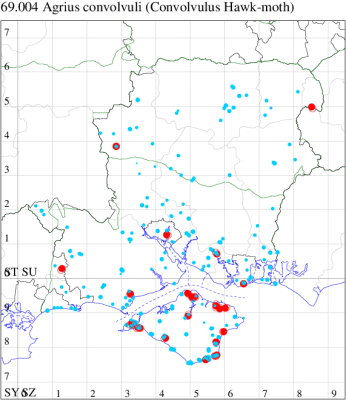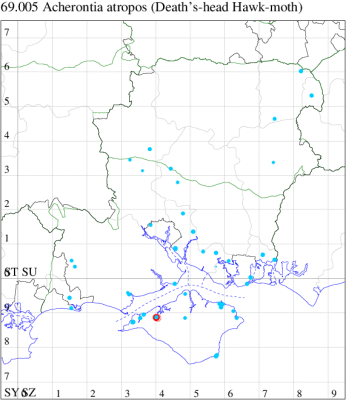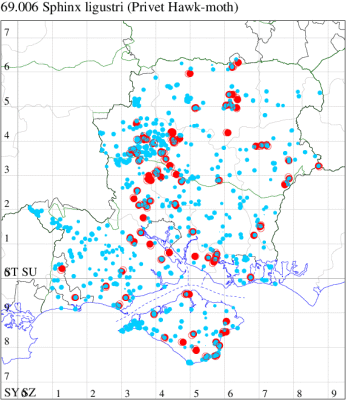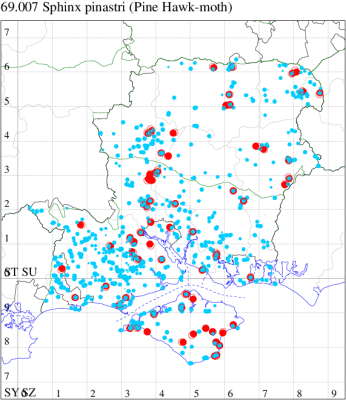2020 Annual Report for: Sphingidae / Sphinginae
For species seen in 2020 that had less than or equal to 100 records, full details are included; for more common species, the earliest, latest and highest count by vice-county are shown. The narrative for each species is taken from the main Hantsmoths website, and it is possible that some information on abundance and occurrence can get out of date, as it is impossible to keep up with all changes; however it should give a good introduction to each species. The tables in each species account summarise the previous status, and that for the current year.
For the maps, all records prior to 2020 are shown by a blue dot (the larger the dot, the more recent), with the current year's records shown in red. As previous records are superimposed on any report for 2020, new sites have greater emphasis (i.e. will show as 'more red').
In the species accounts, an asterisk next to a location indicates a new 10km square record; earliest ever dates are highlighted in orange, and latest ever in red. Initials in the species accounts refer to the recorders listed here. Please get in touch if you identify any omissions or errors, in particular if you have records that have yet to be submitted. Details of how to submit records can be found here.
69.004 [B&F: 1972] Convolvulus Hawk-moth Agrius convolvuli (Linnaeus, 1758) - Migrant
A fairly common migrant from southern Europe, appearing in the south and east, with occasional major influxes (as in 2003), when breeds in small numbers; scattered records throughout Hampshire and the Isle of Wight, most common on the coast, becoming progressively less common inland. Wingspan 94-120 mm. Larva feeds on Field Bindweed and Hedge Bindweed, and also on Morning Glory in gardens, unable to over-winter in significant numbers.
Records prior to 2020
| Vice County | #Records | #Individuals | First Record | Last Record |
|---|---|---|---|---|
| 10 | 218 | 419 | 1849 | 2019 |
| 11 | 280 | 255 | 1935 | 2019 |
| 12 | 70 | 58 | 1951 | 2019 |
2020 records
| Vice County | #Records | #Individuals | Max Quantity |
|---|---|---|---|
| 10 | 34 | 39 | 3 |
| 11 | 5 | 6 | 2 |
| 12 | 2 | 2 | 1 |

Records by year
Records by week (adult)
Records by week (larval)
Record Details
VC10: Totland, one, 19 Sep (RTe); Freshwater, one, field observation, 11 Oct (JWhi det. JBa); Freshwater Bay, one, 14 Sep; one, 20 Sep (SDa); two, to actinic, 13 Sep; one, to actinic, 15 Sep; one, to actinic, 17 Sep; one, to actinic, 19 Sep; two, to actinic, 21 Sep (PBa); Brighstone, one, field observation, 23 Sep (TJnsn det. JBa); Newport, one, field observation, 04 Sep (CFra det. JBa); Cowes, one, field observation, 05 Sep (CToo det. JBa); Ventnor, one, field observation, 08 Sep (WYou det. JBa); Wheelers Bay, one, field observation, 16 Aug; one, field observation, 18 Aug; two, field observation, 01 Sep; one, field observation, 04 Sep; one, field observation, 13 Sep; one, field observation, 14 Sep; one, 16 Sep; one, to actinic, 16 Sep; one, 21 Sep (ABu); Bonchurch, one, 19 Aug; one, 27 Aug; three, 07 Sep (JHa); Shanklin, one, 23 Sep (IOu); Sandown, one, at dusk, seen for three consecutive nights feeding on Nicotiana, 05 Sep (CLin); East Cowes, larva, one, field observation, 07 Oct (CAnd det. JBa); one, field observation, 09 Sep (TBea det. JBa); Binstead, Arnold Road, one, field observation, 01 Sep (SLin); Binstead Primary School, one, field observation, 09 Sep (MTin det. JBa); Ryde, one, field observation, 08 Sep (DMcL det. JBa); one, field observation, 12 Sep; one, field observation, 14 Sep (NWhi det. JBa);
VC11: Brockwood, two, 19 Jun (SDut); Northam, Southampton, one, 02 Sep (MMi); Southampton, one, 31 Aug (MEdg); Fareham, one, ♂ , 02 Sep (KJW); Shirrell Heath, one, 01 Jun (LEdg); Lymington, one, field observation, 01 Sep (RML); Southsea, one, bred, 12 Feb (GRE);
VC12: Over Wallop, one, found dead, 01 Sep (CM); Pamber Forest*, one, field observation, 05 Sep (iNat); Alton, one, to actinic, 22 Aug; one, to actinic, 23 Aug (NDP); Bramshott, one, to artificial light, 22 Sep (MKer); Aldershot*, one, field observation, 03 Oct (Unknown det. MJW)
69.005 [B&F: 1973] Death's-head Hawk-moth Acherontia atropos (Linnaeus, 1758) - Migrant
Rare immigrant from southern Europe, appearing in southern and eastern England, in some years arriving in sufficient numbers to breed in very small numbers. In Hampshire and on the Isle of Wight much less common than Convolvulus Hawk-moth, although the larvae are reported more often. Wingspan 102-135 mm. Unmistakable. Larva feeds on Deadly Nightshade, Woody Nightshade and Potato, causing sufficient damage to be a serious pest in some areas, unable to over-winter in significant numbers.
Records prior to 2020
| Vice County | #Records | #Individuals | First Record | Last Record |
|---|---|---|---|---|
| 10 | 17 | 15 | 1849 | 2019 |
| 11 | 29 | 29 | 1933 | 2018 |
| 12 | 17 | 8 | 1951 | 2016 |
2020 records
| Vice County | #Records | #Individuals | Max Quantity |
|---|---|---|---|
| 10 | 1 | 1 | 1 |

Records by year
Records by week (adult)
Records by week (larval)
Record Details
VC10: Ningwood, larva, one, field observation, 08 Oct (VPer det. JBa)
69.006 [B&F: 1976] Privet Hawk-moth Sphinx ligustri Linnaeus, 1758 - Common
Common on downland and open woodland, and in hedgerows, gardens and fens throughout southern England. Widespread and common in Hampshire and on the Isle of Wight. Wingspan 100-120 mm. Unmistakable. Larva feeds on Wild and Garden Privet, Ash, Lilac and Guelder-rose, over-wintering as a pupa.
Records prior to 2020
| Vice County | #Records | #Individuals | First Record | Last Record |
|---|---|---|---|---|
| 10 | 540 | 862 | 1849 | 2019 |
| 11 | 2168 | 2507 | 1949 | 2019 |
| 12 | 1295 | 1692 | 1948 | 2019 |
2020 records
| Vice County | #Records | #Individuals | Max Quantity |
|---|---|---|---|
| 10 | 94 | 146 | 6 |
| 11 | 193 | 261 | 10 |
| 12 | 130 | 183 | 6 |

Records by year
Records by week (adult)
Records by week (larval)
Record Summary
VC10: Earliest: Bonchurch, 16 May, 1 (JHa) Latest: Sandown, 23 Aug, 1 (Anon) Max count: Bonchurch, 08 Jun, 6 (JHa)
VC11: Earliest: Ashurst, NF, 08 May, 1 (SAB) Latest: West Wood, Farley Mount, 12 Aug, 1 (MMi) Max count: Horndean, 25 Jun, 10 (JAN)
VC12: Earliest: Overton, 10 May, 1 (MSi) Latest: Alton, 11 Aug, 1 (NDP) Max count: Beech, 23 Jun, 6 (NDP)
69.007 [B&F: 1978] Pine Hawk-moth Sphinx pinastri Linnaeus, 1758 - Local
Local in coniferous woodland, plantations, heathland and gardens throughout much of south-eastern England. In Hampshire and on the Isle of Wight a species which has spread rapidly since the middle of the 20th Century, but has declined since, although still widespread but never common wherever there are pine trees. Wingspan 72-80 mm. Unmistakable, there are three or four black dashes in disc, and the forewing fringe is chequered. Larva feeds mainly on Scots Pine and Norway Spruce, but also on Maritime Pine and Cedar-of-Lebanon, over-wintering as a pupa.
Records prior to 2020
| Vice County | #Records | #Individuals | First Record | Last Record |
|---|---|---|---|---|
| 10 | 212 | 224 | 1946 | 2019 |
| 11 | 3121 | 3359 | 1945 | 2019 |
| 12 | 528 | 522 | 1951 | 2019 |
2020 records
| Vice County | #Records | #Individuals | Max Quantity |
|---|---|---|---|
| 10 | 37 | 39 | 2 |
| 11 | 95 | 110 | 4 |
| 12 | 42 | 51 | 2 |

Records by year
Records by week (adult)
Records by week (larval)
Record Summary
VC10: Earliest: Rookley, 23 May, 1 (JBa) Latest: Shanklin, 09 Aug, 1 (IOu) Max count: Kingston, 17 Jun, 2 (ENes)
VC11: Earliest: Sway, 10 Apr, 1 (SKe) Latest: Burton, nr Christchurch, 15 Sep, 0 (JSw) Max count: Kings Somborne, 31 Jul, 4 (GCE)
VC12: Earliest: Liss Forest, 08 May, 1 (RJM) Latest: Eelmoor Flash, 22 Sep, 1 (JHac) Max count: Goodworth Clatford, 23 Jul, 2 (GCE)